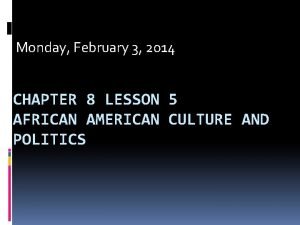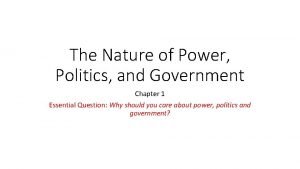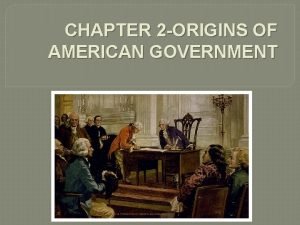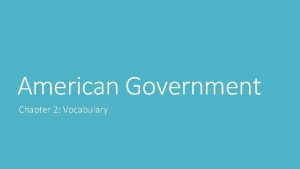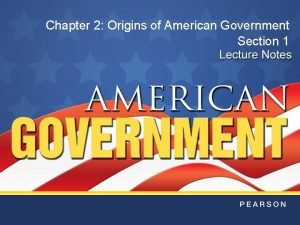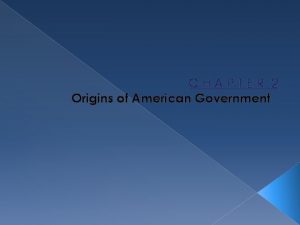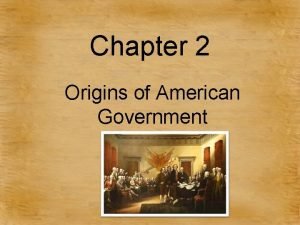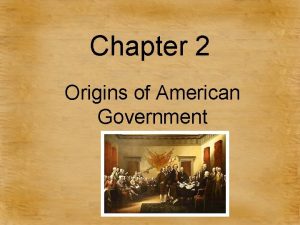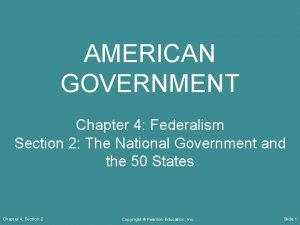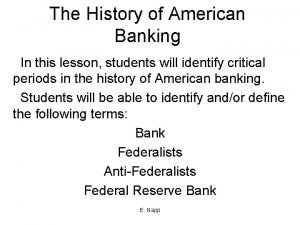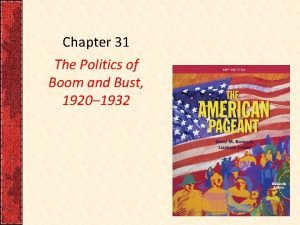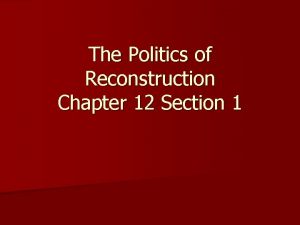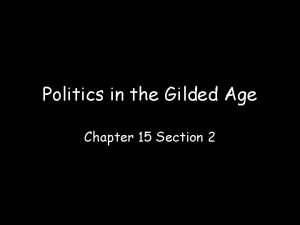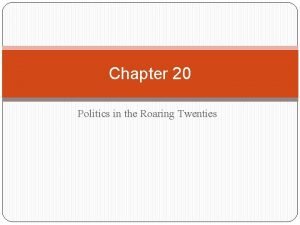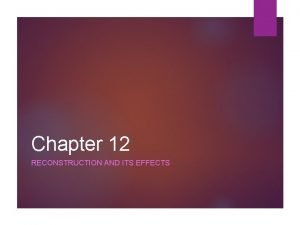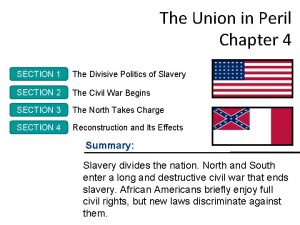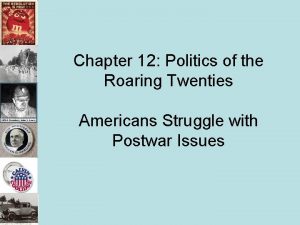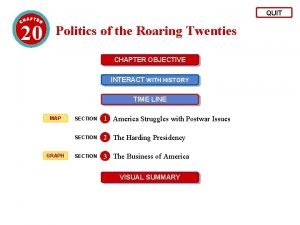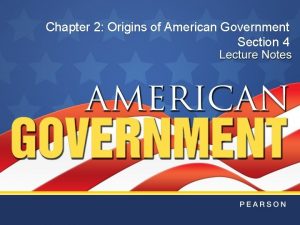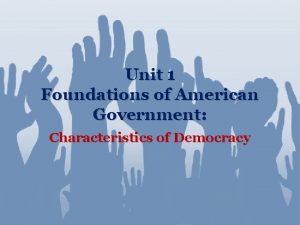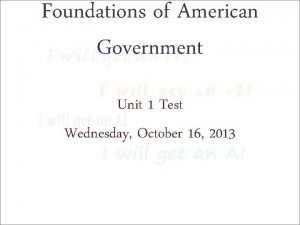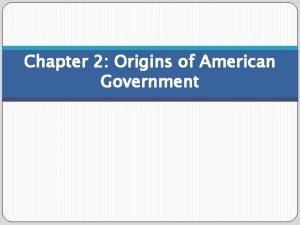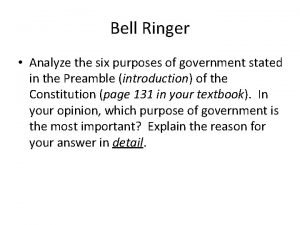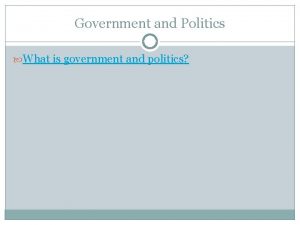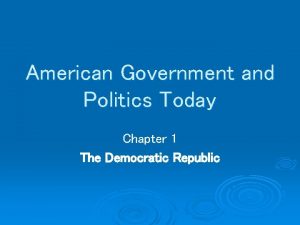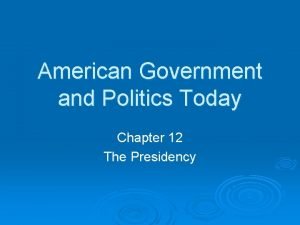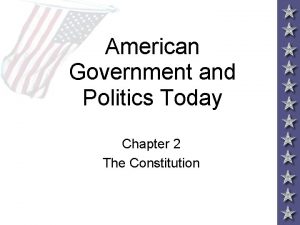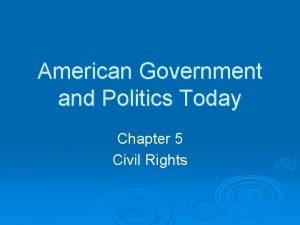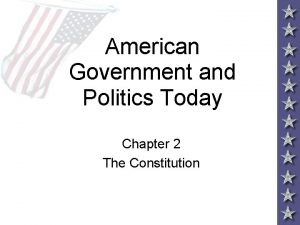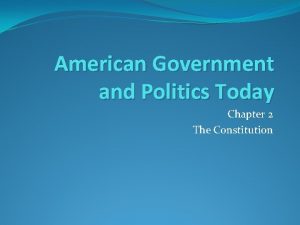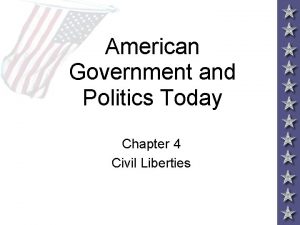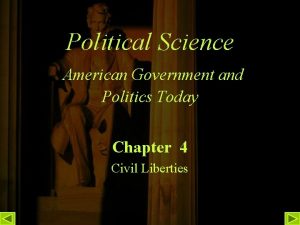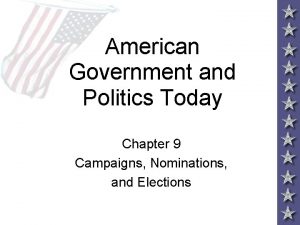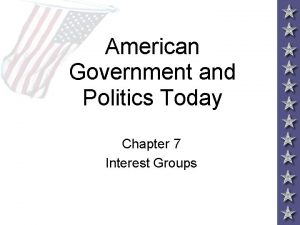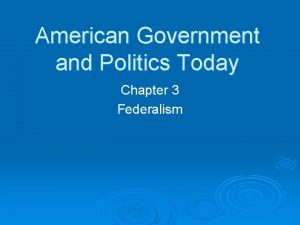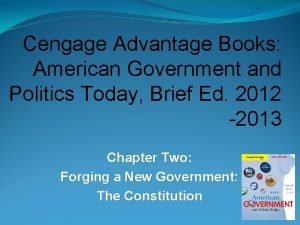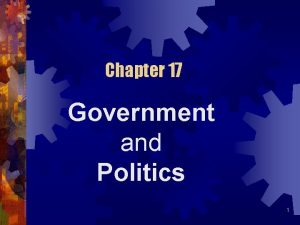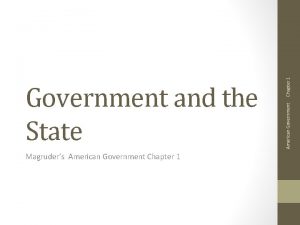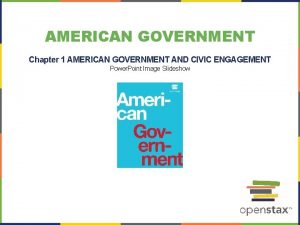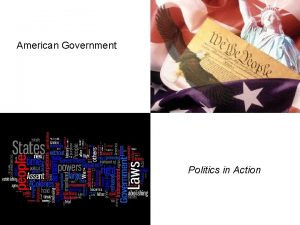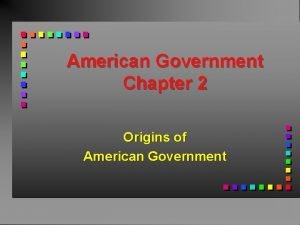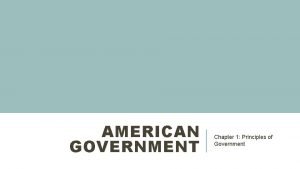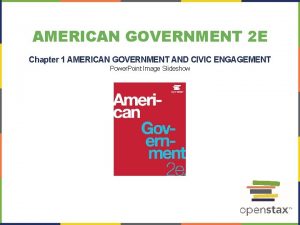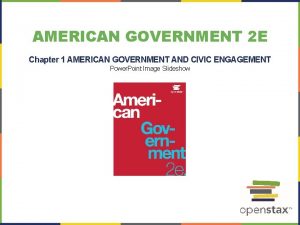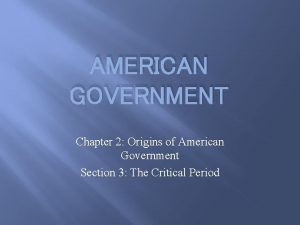American Government and Politics Today Chapter 2 The


































- Slides: 34

American Government and Politics Today Chapter 2 The Constitution: What if Constitutional interpretation never changed?

The Colonial Background Ø Ø Ø Separatists were upset with the Church of England wanted a place where they could practice their religious beliefs. In 1620, they landed at Plymouth (Mass. ) after sailing on the Mayflower Wrote the Mayflower Compact on Nov. 21, 1620

British Restrictions and Colonial Grievances l Ø Ø After the French & Indian Wars, the British began taxing the American colonists severely -Sugar Act (1764) -Stamp Act (1765) -”Intolerable Acts (1774) Why? The major reason for these laws was to raise revenue to help pay off the war debt that stemmed from the French and Indian War

First Continental Congress l l Called in Sept. 1774, but there was little talk of independence The focus was to restore the political structure that was in existence before the passage of the unfair taxes -to create a list of grievances to be sent to King George III

l Had the Crown and Parliament relented on many of their demands it is possible the Declaration of Independence would never have been issued.

Second Continental Congress l l Called May 1775, and things have changed Fighting had already taken place; where? Congress established an army. Made Washington the general in chief and pursued the Revolutionary War.

COMMON SENSE Early 1776, Thomas Paine’s Common Sense was published Ø The pamphlet made observations in the colonies concerning the relationship with Britain Ø This would be the inspiration for the Declaration of Independence Ø

The Declaration of Independence l l Based on ideas developed by John Locke (Two Treatises on Government) written in 1690 Natural Rights • Natural rights: life, liberty, and the pursuit of happiness

l Social Contract • Based on the idea of consent of the governed, and that governments had the responsibility to protect the natural rights of its citizens. • If the government failed to do so, the people had the right to revolt.

The Decision for Independence • In July 1775, the Continental Congress sent the Olive Branch Petition to the king. -said that the colonies were still loyal to King George III -asked the king to call off the army while a compromise could be made. • -he refused to look at it On July 4, 1776, Continental Congress accepted a document written by Thomas Jefferson. -stated why the colonies had to separate -pleaded with other countries to understand not get involved • -Sent Declaration of Independence to King George Click the mouse button or press the Space Bar to display the information.

AFTER THE AMERICAN REVOLUTION After the American Revolution, the colonies now had the task of setting up a new independent government Ø The first form was The Articles of Confederation on Mar. 1, 1781 Ø 13 states were in a “league” together Ø Congress was a unicameral house with the members of each state (usu. 2 -7) would have only one vote / state Ø

Led by a President of Congress (not to be confused with a President of the Executive Branch) Ø See chart on next slide for powers of Congress Ø Accomplishments: (1) settlement of western terr. Claims (2) Northwest Ordinance of 1787 Ø What were the weaknesses? Ø


Ø The primary reason for the establishment of the Articles was to organize the states so they could defeat the British forces and gain independence from Britain. -States retained most of the power and the central government had a very limited role in the governing process. l -The loyalty most citizens had was to their state first and foremost.

l l Shay’s Rebellion – farmers were upset about the treatment of the debt that the farmers owed Quickly put down, but demonstrated the lack of power the central govt. had to protect the people

The Confederal Government Structure Under the Articles of Confederation

THE NEED FOR A CHANGE Ø Ø Due to the problems with the A. O. C. , many saw the need for a change. May 14, 1787, delegates met in Philadelphia to “revise the A. O. C. ” Every state sent delegates except R. I. Once they began looking at the A. O. C. , they realized that it was useless

Instead they decided to throw out the articles and start over Ø They worked in secret all summer because if they were found out, it could be considered treason Ø But, from the start, there were disagreements amongst the delegates Ø

Framers of the Constitution – – – Anti-Federalist (Republicans) opposed any centralization of power. Federalists favored a stronger central government The beliefs of the delegates ranged from the nearmonarchism of Hamilton to definite decentralized republicanism. Some of these last people left when they saw the federalist tenor of the proceedings. One of the most contested debates centered on the Congress

Politicking and Compromises: The Virginia Plan called for a bicameral house -lower house chosen by people -upper house chosen by lower house Ø # of rep. based on population thus favoring larger states Ø Est. an executive branch Ø Est. a national judicial system Ø

Politicking and Compromises: The New Jersey Plan “one state, one vote” Ø Congress could regulate trade and impose taxes Ø All Congressional acts would be the supreme law of the land Ø Est. a executive branch which would create a Supreme Court Ø

The Great Compromise: The Connecticut Compromise Ø Bicameral house (H. of Rep. & Sen. ) -H. of Rep. = based on population and would chose the Sen. -Sen. would be 2 / state

Politicking and Compromises: The Three-Fifths Compromise Ø Ø Ø Northern states wanted to ban the importation of slaves, while Southern states did not. Southern states wanted slaves counted in the population for the purposes of determining the number of members each state sent to the House of Representatives, but not for property taxes.

The Three-Fifths Compromise provided that 3/5 of the slaves would be counted (or each slave would count as 3/5 of a person. ) Ø This did stop the bickering over slavery, but it did ensure that slavery would continue until the next generation Ø

Working Toward the Final Agreement --Separation of Powers - The legislative, executive, and judicial powers to be independent of each other

– Checks and Balances. --each branch can check the actions of the others branches (p 54) – Selecting a President -- Electoral College meant that the president was not to be chosen by Congress, but not by a popular vote, either.

The Final Document popular sovereignty – a republican government – a limited government – a federal system where both the national and the state governments each have their own sphere of influence. –

Ratification Ø The Federalist Papers • An attempt to persuade the public to support the new form of government. • Federalist #10 and Federalist #51 provide an excellent view of James Madison’s political theory concerning human nature

The March to the Finish The vote by the Virginia ratification convention was essential and somewhat close. – The New York vote was even closer and put the Constitution “over the top. ” – At this point, North Carolina and Rhode Island had little choice but to join. –

Support for the New Constitution • Beard’s Thesis -Historian Charles Beard argued that the Constitution was put through by an undemocratic elite intent on the protection of property. • State Ratifying Conventions -These conventions were elected by a strikingly small part of the total population.

• Support Was Probably Widespread. ØBut the Const. was too strong for some ØRequired that the Const. provide some protection for ind. liberties

The Bill of Rights Ø “Bill of Limits” —No Explicit Limits on State Government Powers. — Did not apply to state governments. —The restrictions only were applicable to the national government until the 14 th amendment incorporated some of these rights.

The Formal Amendment Process Every government needs to be able to cope with new and unforeseen problem. – Any Constitutional change should, however, be taken with extreme caution. – If the process to amend the Constitution is rigorous, there should be ample time to consider the merits of such a change. –

Informal Methods of Constitutional Change Ø Congressional Legislation Ø Judicial Review Ø Interpretation, Custom, and Usage
 Chapter 8 lesson 5 african american culture and politics
Chapter 8 lesson 5 african american culture and politics Whose government politics populists and progressives
Whose government politics populists and progressives Government study guide unit 1
Government study guide unit 1 The nature of power politics and government
The nature of power politics and government Chapter 2 american government
Chapter 2 american government Chapter 2 origins of american government vocabulary
Chapter 2 origins of american government vocabulary Chapter 2 origins of american government answer key
Chapter 2 origins of american government answer key Chapter 2: origins of american government worksheet answers
Chapter 2: origins of american government worksheet answers Chapter 2 lesson 1 government in colonial america answers
Chapter 2 lesson 1 government in colonial america answers Chapter 2 origins of american government
Chapter 2 origins of american government American government chapter 4
American government chapter 4 Today meeting or today's meeting
Today meeting or today's meeting We are going today
We are going today Proposal kickoff meeting agenda
Proposal kickoff meeting agenda Fingerprint ridge characteristics worksheet
Fingerprint ridge characteristics worksheet Today's lesson or today lesson
Today's lesson or today lesson Today's lesson or today lesson
Today's lesson or today lesson Lesson 2: the history of american banking and banking today
Lesson 2: the history of american banking and banking today Chapter 31 the politics of boom and bust
Chapter 31 the politics of boom and bust What are the three levels of government
What are the three levels of government The politics of reconstruction chapter 12 section 1
The politics of reconstruction chapter 12 section 1 Chapter 15 section 3 politics in the gilded age
Chapter 15 section 3 politics in the gilded age Chapter 20 politics of the roaring twenties answer key
Chapter 20 politics of the roaring twenties answer key Chapter 12 reconstruction
Chapter 12 reconstruction Chapter 4 section 1 the divisive politics of slavery
Chapter 4 section 1 the divisive politics of slavery Chapter 7 section 3 politics in the gilded age
Chapter 7 section 3 politics in the gilded age Politics of the roaring twenties chapter 12
Politics of the roaring twenties chapter 12 Chapter 20 politics of the roaring twenties answer key
Chapter 20 politics of the roaring twenties answer key Chapter 20 politics of the roaring twenties
Chapter 20 politics of the roaring twenties Origins of american government section 4
Origins of american government section 4 Unit 1 foundations of american government
Unit 1 foundations of american government Origins of american government section 1
Origins of american government section 1 Foundations of american government unit test
Foundations of american government unit test Origins of american government section 1
Origins of american government section 1 What are the 6 purposes of government
What are the 6 purposes of government
